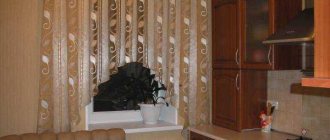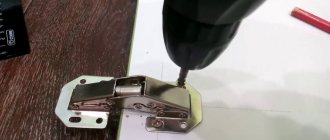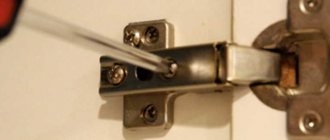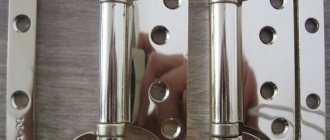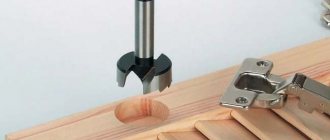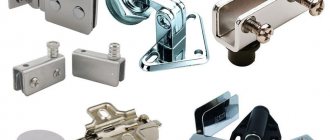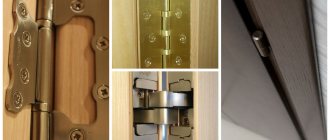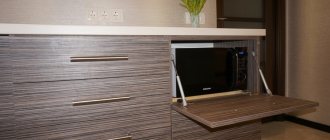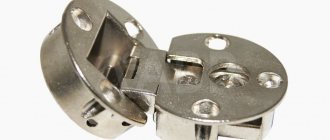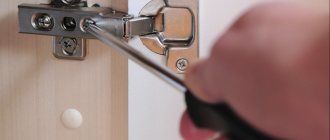Many people, in order to save money, when buying furniture, decide to assemble it themselves, so as not to pay for the services of an assembler if they come for a separate fee. In fact, it is very easy to assemble modern interior items, following the included instructions and having at least minimal skills in working with the tool. However, there are still some nuances. For example, installing furniture hinges with your own hands is a fairly simple task, but one that requires attention and accuracy, because how well the doors of cabinets and cabinets will close will largely depend on correct installation.
Installing furniture hinges yourself
Design features and operating mechanism
The loop consists of the following elements: cup (1), shoulder (2), striker (3). The cup is inserted into a blind hole in the door, which is drilled with a milling cutter and fixed with two self-tapping screws through holes located on the flange (5).
A counterplate is fixed to the furniture wall with self-tapping screws, which is attached to the arm (2) and the cup using a mounting screw (6) and a mounting groove (7). An adjustment screw (8) is located on the arm to adjust the height of the arm relative to the strike plate and align the door after installation.
Design features of furniture hinges
To work you will need:
- drill: thin drills, milling attachment with a diameter of 35 mm;
- pencil, tape measure (ruler);
- screwdriver or Phillips screwdriver;
- building level.
Installation
First, mark the location of the loops in height. The number of furniture hinges depends on the dimensions and weight of the door leaf.
The distance from the top and bottom edges of the fabric to the loop must be at least 70 mm. Otherwise, the lower and upper horizons of the box may touch the loop.
It is convenient to make markings using a special device - a conductor
Then mark the location of the hole for the cup on the facade. To do this, at the required height from the edge of the blade to the center of the drilling, measure 21-23 mm.
The blade is placed on a hard and stable surface, and they begin to drill a “blind” hole with a milling cutter. All holes are located perpendicular to the plane of the facade and have a depth of 11-12 mm. After work, small shavings are collected with a vacuum cleaner.
If you have no experience working with a cutter, especially with centering tenons 3 mm long, it is advisable to practice on scraps of board.
And another option is to shorten the tenon using a grinder or sandpaper. Otherwise, you can drill through the canvas.
The cup is inserted into the holes, aligning the loop perpendicular to the edge. The holes for the screws are marked with a pencil, the hinges are removed, and the markings are deepened with a thin drill. The cups are placed into the holes and secured with self-tapping screws.
If you have no experience working with a cutter, you need to practice on scraps
Now you need to attach the facade to the cabinet frame, align it vertically and mark the places where the striker is attached. They are deepened with a drill, and the counter plate can be screwed on with self-tapping screws.
To ensure that the hinges are installed as level as possible, they can be supported with a wooden or metal strip.
Next, the façade is installed. A shoulder groove is inserted under the mounting screw of the bar. At the same time, make sure that the adjusting screw matches the groove on the strike plate.
Materials and tools
You need to start assembling furniture with a selection of materials and tools that will be needed for the job. It is necessary to take into account the structure of the materials, because there are different types of wooden surfaces. They will require different fastening devices and fastening methods. The main methods of fixation are the lower and upper positions. For massive sashes over a meter long with heavy weight, add another hinge in the middle. For installation of doors over nine kilograms. The maximum number of loops for a product weighing 20 kg will be 5 pieces.
Assembly of furniture does not require complex mechanisms. The necessary set of tools consists of simple, familiar things. To install the fasteners on the door, the following tools are required:
- self-tapping screws (4x16mm);
- roulette;
- hammer;
- drill;
- screwdriver;
- screwdriver;
- pencil;
- level;
- chalk.
Before installing the hinges, you need to select the material for the job. The main material is the fastening device. There are many types of hinges on the hardware market, they may differ:
- design;
- material;
- design;
- functions;
- style.
They are selected based on the types of material, dimensions, and type of furniture. Separate fastening devices are used for furniture that meets certain design styles. For ordinary cabinet doors, standard semi-overlay and overhead fasteners are used.
When choosing fastening devices, it is better to give preference to industrial certified products. This will extend the life of the furniture. The selection of hinges should be comprehensive, taking into account all the materials necessary for fastening:
- fastening devices for large cabinets perform the functions of opening the doors. According to technical characteristics, these are mechanical parts;
- The materials from which the doors are made are of no small importance; one of the significant indicators is their thickness;
- The material of the hinges is also taken into account: they are made from alloys that are resistant to deformation and corrosion.
Overhead fasteners with four hinges have one fastening principle:
- the cups lying at the base of the fastening device are connected to the panel;
- The inserts are placed in the bases and secured to the side of the body.
Decorative
With door closer
Card
Without insert
The service life of these mechanisms exceeds permissible standards due to the reliability of the connections. To better understand the process of attaching a hinge to a cabinet, you need to have a good understanding of the types of fastening devices. Universal hinges on four hinges have a good margin of safety:
- the range of their opening angle when mounted on cabinet doors ranges from 90 to 165o;
- they can be adjusted in three different planes;
- the fastening device consists of two elements: the strips will be installed on the side wall of the furniture;
- the hinges will be screwed to the cabinet doors.
Adjustment and Leveling
At this stage, you need to work at the construction level - determine the correspondence of the frame parts to the door leaf. To do this, the level is applied to 3 planes - to the two sides and to the front. They should be as even as possible. That is, there should be no gaps or deviations between the frame and the door leaf.
Alignment begins with adjusting the vertical gap. To do this, pressing the facade against the frame, tighten the fixing screws on the strip. Then close the door and check the possible angles of inclination with a building level.
By adjusting the screws, all gaps between the facade and the frame are eliminated. For example, if the upper corner is tilted to the right, tighten the screws on the upper hinge and loosen the screws on the lower one.
Then they begin to adjust the doors according to their height. Two self-tapping screws located on the “ears” of the strike plate are responsible for this. To begin with, loosen the screws on all hinges, raise or lower the canvas (depending on the situation). Then tighten the screws until they stop, holding the facade in the desired position.
If the door does not press well against the frame body or when pressed the opposite side bounces off, then adjustment of the hinges along the plane is also necessary. To do this, tighten the adjusting bolts located on the bar.
Installing hinges on glass doors
The installation principle is the same as for wooden doors.
Four-hinged hinges for glass doors are distinguished by the presence of a special tab for attaching the cup and a cover for masking the device from the outside.
If you have no experience working with glass, it is better to turn to specialists to drill holes. Before this, you need to establish preliminary markings of the locations of the loop cups. At the same time, they also take into account the hole where the handle will be hung.
Overhead hinges are also used for glass doors, which can be hung without drilling glass.
You need to place and secure the cup in the drilled holes using a tab, and attach the counter plate to the box with self-tapping screws. Afterwards the door is aligned along three planes.
For glass doors, overhead hinges are also used, which can be hung and fastened without drilling the glass. They are mounted inside the box; accordingly, all shelves in the closet must be recessed inward. Suitable for light sashes only. For example, for the bookcase department.
Quality of installed hinges
A greedy furniture maker, purchasing hinges at a wholesale base, takes into account one single factor - cost. Such dealers simply don’t care about the quality of the fittings. They know that this product will function normally for a while, and when everything starts to fall apart, it will be too late to change anything. So the cheapest furniture hinges are sold out, they are installed in cabinets, and then the mezzanine doors fall off and fall on the client’s head at the most inopportune moment.
Why do furniture manufacturers save on hinges? The situation on the furniture fittings market is such that a furniture maker can, instead of one high-quality, solid European hinge, buy three cheap ones, stamped from thin tin cans in the poorest Chinese neighborhoods. And with wholesale purchases, decent savings are obtained, for the sake of which some furniture manufacturers easily step over their conscience.
How to determine the quality of a furniture hinge? To an inexperienced client who has difficulty distinguishing a self-tapping screw from a bolt, slob furniture makers sell crap under the guise of an expensive exclusive. They open the cabinet doors in front of his nose and say: “Just look at how well and softly the furniture hinge works! Do you know why it glows in the dark? Yes, because this is Honduras – the leading nuclear waste processing plant!”
In fact, anyone can easily learn to understand the quality of furniture hinges. You just need to pay attention to the thickness of the metal. The thicker the metal, the better the loop. But how do you know that this hinge has thick metal and will withstand the load? After all, you need to have a standard for comparison! I think the right decision would be to go to a wholesale center that sells furniture fittings and talk to the sellers. Let them show you cheap hinges and give you the opportunity to hold expensive, high-quality hinges in your hands. This way you can really understand the difference between cheap crap and a good product. Well, then, write down the markings of a quality hinge and the name of the manufacturer in a notebook in order to indicate this data in the contract for the manufacture of furniture. And just let them try to install something else for you!
By the way, start expanding your horizons by reading our publication: Types of furniture hinges - this is a very educational material that talks about the most popular types of hinges among furniture makers. Well, then - forward to the wholesale base for the sale of furniture fittings!
Kinds
Four-hinged hinges come in different modifications, which can be selected depending on the location of the panel relative to the box and the cabinet itself in the room.
Invoice
The canvas attached to this loop is completely perpendicular to the body and covers the stand. Used when the door overlaps the side rail of the cabinet.
Invoice
Half waybill
It is used when two doors need to be hung on one rack. Each facade overlaps the end of the rack by half.
Insert
The door leaf is perpendicular to the post, but does not overlap its end.
The overhead hinges also differ in the angle of inclination. This is necessary for installing corner cabinet doors. Depending on the difference between the angle of the facade and the perpendicular to the stand, you can select hinges with an opening angle: -25 °, 30 °, 45 °, -45 °, 90 °.
Insert
Transformer
Used to create composite facades from several doors or in cabinets with drawers that are hidden
Most four-hinged hinges are made with a built-in closer. This makes the door movement smooth and silent.
Transformer
Eight-joint
It has all the characteristics of a four-hinged hinge, only without inserting the cup into the facade body. It is attached with self-tapping screws, so it is only suitable for fabrics with a dense texture.
Eight-joint
Other types of furniture hinges
Card, piano, and hinge hinges are rarely used for installing cabinet doors. They do not have three-level adjustment and do not lock the door in the open and closed position. An additional fastener is needed. Today they are more often used as an additional decorative element. For example, antique.
Mezzanine
For installation of horizontal overhead panels that open upwards.
Mezzanine
Secretaries
Used for hanging downward opening facades.
Secretary room
We have learned in our practice how proper installation and adjustment of hinges affects the operation of the cabinet as a whole. Some time after assembly, the door of the wardrobe or kitchen cabinet stopped closing - the upper part of the door rested on the frame.
To correct the misalignment and use the cabinet normally, I had to readjust all the hinges. Therefore, during installation, it is advisable to prevent any deviations; any gap can lead to deformation of the entire cabinet structure.
Purpose of hinges for kitchen facades
First of all, hinges for furniture doors are needed to secure the facades to the body. They also make it possible to open and close swing doors. The possibility of adjusting the facades themselves (thick, radius), the degree of fixation of the doors, the maximum possible angle of the doors when opening, the smoothness of the free movement of the doors, the absence of creaks, distortions and other possible defects depends on which hinges will be selected.
Mounting device and features
The most popular model for the facades of kitchen cabinets are four-hinge hinges, popularly called “frogs”. This design is very durable, has the ability to adjust the position of the facade and a stopper to prevent arbitrary opening of the doors. You can read about the standard sizes of kitchen units in this material.
The production of four-hinged hinges occurs by stamping sheet metal (steel). The product is covered with a layer of galvanic coating on top, which provides an aesthetic appearance and protection against rusting (corrosion). They can also be covered with various decorative coatings, making the surface matte, chrome or colored.
Parts of a four-joint hinge:
- Cup. It has a square shape with rounded corners. Inserts into the hinge hole on the inside of the door. And it is attached using self-tapping screws; it is possible to use an additive.
- Shoulder. Four-joint mechanism that acts as a lever for opening/closing.
- Mounting plate required for installation. The hinge body is attached to the strike plate. Special screws can be used to adjust the position of the facade.
Additionally, the kit may include:
- Bowl covers.
- Shoulder pads.
- Closers (allow the hinge to close smoothly).
Types and sizes
- Invoices. When attaching the hinges to the facade in this way, it is completely closed on the side, eliminating gaps. When the door is closed, the angle between the facade and the side of the box is 90 degrees. When the door is open, this angle is 110 degrees. This fastening option is used in cases where it is necessary to cover the open part of the box with one or two doors.
- Semi-overhead. Such loops have a bend at their base. Installed on the facade, they cover half of the side of the box. The hinge angle when closed is 90 degrees, when open it is 110 degrees. They are used if there is a need to install hinges on one partition in order to open the doors in different directions (when installing overhead hinges, the doors will not be able to open).
- Deposits. They are installed inside the box and have a large bend at the base. When using these types of hinges, the sides of the box are visible. The hinge angle when closed is 90 degrees, when open it is 100 degrees. They can be attached to the sides of the box or to its partitions.
- Angular. Hinges are used for installation on corner drawers. In this case, the width of the side parts that are located next to the facade must be the same. The hinge angle when closed is 45 degrees, when open it is 95 degrees.
- Inverse. Installed when it is necessary to open the door completely. The angle of the hinge when open is 180 degrees, the facade is located on the same straight line with the sidewall of the box.
- Piano hinges are single-hinged. They are rarely used because without an additionally installed magnet the doors do not close completely. Most often they are mounted on furniture with a top-opening door.
- Card. The structure is similar to piano hinges: two hinge plates are mounted parallel to the hinge. Installed on retro style furniture.
- Mezzanine. Used when it is necessary to open the facade upwards. The principle of operation is similar to door closers, only the mezzanine ones have a spring installed, which allows the doors to smoothly open and close.
- Secret. They are arranged according to the principle of piano and card games. Installed on furniture whose doors open downwards.
- Ombre. Installed on folding facades. Often used to make kitchen folding tables.
- Pendulum (bar). Spring hinges, which are similar in structure to piano hinges. They ensure the opening of facades by 180 degrees (following the principle of fittings for bar counters in Mexican countries).
- Heel. They are used extremely rarely, because to install such hinges the door must be light in weight, mainly for small corner kitchens.
Types of furniture hinges, how to choose:
